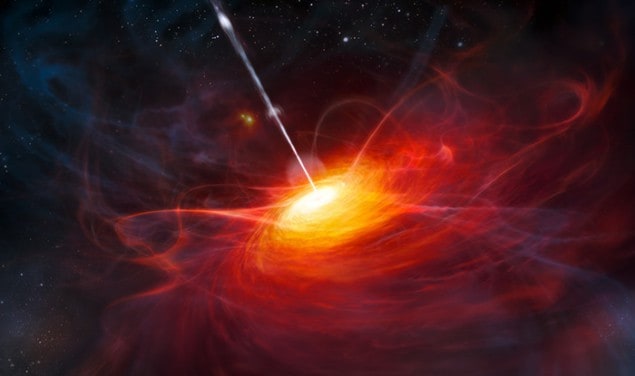
Is the fine-structure constant different in different parts of the universe? The answer to this intriguing question could be one step closer, thanks to a new way of locating the frequencies of electronic transitions in highly charged ions. The new technique was created by an international team of physicists, and could also be used to identify candidate ions to make new and more precise atomic clocks.
The fine-structure constant (α) defines the strength of the electromagnetic interaction, and observations of the light from distant quasars suggest that it may vary throughout the universe. If these variations are real, α should also change in the laboratory by about one part in 1019 per year, as the Earth travels through the cosmic microwave background. In principle, this variation could be measured in an atomic clock based on an atomic transition that is very sensitive to tiny changes in the fine-structure constant. The problem with this technique is that transitions in neutral atoms or singly charged ions are adversely affected by stray electromagnetic fields and black-body radiation – and to make matters worse, these transitions are not sensitive enough to changes in the fine-structure constant for the measurement to achieve the desired level of precision.
Electron stripping
In 2012 physicists in Australia and the US suggested that atomic clocks accurate to one part in 1019 could be made using electronic transitions in ions that have been stripped of many electrons. This is because removing electrons from an atom leaves the remaining electrons more strongly bound to the nucleus. This, in turn, makes atomic transitions in the ion less sensitive to noise and more sensitive to the fine-structure constant.
The researchers focused on “level-crossing” transitions, where two energy levels swap places as the atomic number increases. At the crossing points, the energy of the transitions is very small and can be excited with an optical laser. Such transitions are very narrow, which makes them perfect for producing an accurate clock. However, it is extremely difficult to calculate the exact frequency at which such a transition occurs – and not knowing the exact frequency combined with the narrowness of the transition makes it extraordinarily difficult to locate in a practical laboratory experiment.
In this latest work, a team of physicists including some of those involved in the 2012 calculations focused on transitions in the ion Ir17+, which are of particular interest because they should be very sensitive to changes in the fine-structure constant as small as 10–20 per year. The team also looked at similar transitions in several other highly charged ions that neighbour Ir in the sixth row of the periodic table. In all cases, they were able to calculate and then observe the frequencies of the transitions of interest.
Painstaking preparation
“These ions that we were studying had never been observed,” says José Ramón Crespo López-Urrutia, who leads a research group at the Max Planck Institute for Nuclear Physics in Heidelberg, Germany, and was part of the team. The researchers therefore had to painstakingly prepare individual samples of these ions before trapping them and exciting them with an electron beam.
The team looked at spectral lines in the light emitted by each set of excited ions, and used a computer algorithm to look for lines in different samples that varied in the expected way, showing that they had all come from the same transition. Using this technique, the researchers assigned almost all of the transitions between the various energy sub-levels. Despite their success, however, they were still left with two possibilities for which spectral line corresponds to the best transition for measuring the fine-structure constant. Using the scaling laws they had developed, the researchers went on to make accurate predictions for the energies of key transitions in two other highly charged ions – Hf12+ and W14+ – that are good candidates for atomic clocks because they are less sensitive to noise.
The researchers now have to cool their highly excited ions to millikelvin temperatures before they can perform precision laser spectroscopy to determine the exact frequencies of the transitions. They are hopeful of success because earlier this month, researchers in López-Urrutia’s group demonstrated such cooling of Ar13+ions.
Laser locking challenge
Wolfgang Quint, of the Helmholtz Institute in Jena, Germany, is impressed with the work. However, Quint, who was not involved with the research, says that even with the millihertz precision achieved by the researchers, much more work needs to be done before they will be able to lock a laser onto a transition and measure α. Mikhail Kozlov, of the Petersburg Nuclear Physics Institute in Russia, adds, “If there is a clock using highly charged ions, I’m not sure that it will be made from one of these ions.” But this method should enable further observation of other transitions in other ions before a final decision about the most appropriate one is made, he says.
The research is described in Physical Review Letters.



